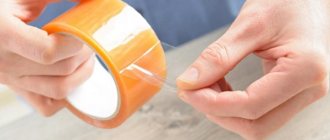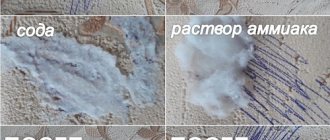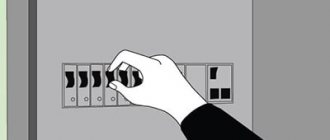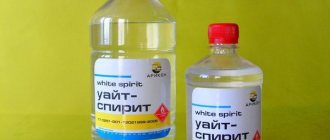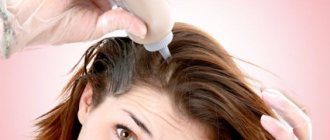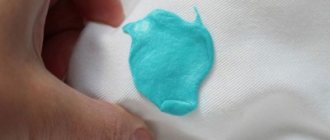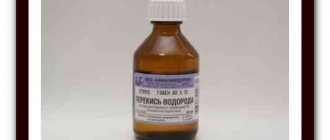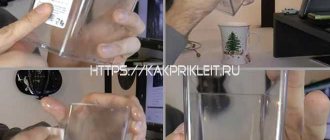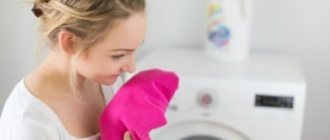How to peel off tape without leaving a trace
It is much easier than dealing with glue residue to remove the tape without leaving any traces. How? The surest way is to heat the adhesive base:
- Use a hairdryer to pass over the entire surface of the tape for 30 seconds, then carefully pick up a corner and check whether the tape can be easily removed. If not, then wait another half a minute. Then slowly peel off the tape away from you, continuing to heat the adhered areas. Please note that excessive heating with a hairdryer can lead to deformation of plastic windows and glass.
- Hot water . After wetting the sponge, apply it for a few minutes to allow the glue to heat up, and then wipe off the tape with the soft side.
To remove tape from glassware, place it in a sink filled with hot water. Within an hour, the tape will peel off and leave no traces.
Important: Sudden temperature changes often cause glass to crack. Therefore, the dishes must first be allowed to stand at room temperature.
If you cannot heat the tape for any reason:
- A scraper, blade, or utility knife, when used carefully, will help clear the adhesive and tape.
- A plastic card or a disposable knife can easily replace them with sharp tools and will not leave scratches.
Additional funds are needed if the tape has been glued long enough, more than 72 hours. Therefore, the main recommendation is to dismantle the tape as early as possible. In any case, do not rush: remove the tape slowly, without sudden movements. Then there will either be no traces at all, or their number will be minimal.
Cleaning plastic
Low porosity, high density and good heat resistance are a set of characteristics inherent in plastic surfaces. At the same time, plastic is characterized by low resistance to chemical and mechanical influences. Chemical reagents and aggressive solvents cannot be used to remove tape. Products with a pungent odor are also contraindicated for plastic - they are easily absorbed into the layers, but it takes a long time and is difficult to erode.
Heat – to remove tape and marks
Heat will help remove the tape. The method is applicable for surfaces made of dense and durable plastic. The exposure temperature should not exceed a threshold of 70–80 °C.
Thermal influence is applied in relation to:
- To the tape. The tape must be heated and simultaneously removed from the plastic surface. The adhesive backing will soften and come off along with the tape.
- To the glue marks.
If the tape is removed, but traces of glue remain, proceed based on two diagrams:
- Continue heating until softened. A rubber spatula will help clean the softened, warm composition.
- After softening the adhesive base, apply a soap solution and clean the surface.
- Repeat the procedure until the desired result is achieved.
The method is effective both in relation to fresh traces and old ones.
Alcohol removes glue and yellowness
It will help not only to remove the glue from the tape, but also to transform the appearance of the plastic, neutralizing the yellowness.
Application:
- Soak a gauze pad in ethyl medical alcohol.
- Treat the problem area until traces of the tape are completely removed.
When applying alcohol, it is better to use a soft, lint-free cloth to speed up the process.
Mustard and vinegar
You will need:
- mustard powder – 3 tbsp. l;
- warm water – 1 tbsp. l;
- table vinegar (9%) – 1 tsp.
Mode of application:
- Mix the stated ingredients until a paste is obtained.
- Apply the paste onto a sticky layer of tape.
- Leave for 5-7 minutes.
- Remove residues with a sponge or cloth without applying pressure.
- Rinse off the cleanser with warm water.
The mixture acts as a solvent and is only applicable to dark or opaque plastic, since exposure to light or transparent surfaces can result in yellowing and streaks.
Removing glue marks
After the tape has been removed, glue marks often remain. This problem especially often occurs after packing tape and all kinds of mounting tapes.
Various chemicals will be effective in this case:
- acetone or nail polish remover (NOT for matte surfaces);
- ammonia or technical alcohol;
- furniture polish;
- glass cleaning liquid;
- multi-purpose lubricants such as wd-40;
- White Spirit;
- gasoline or kerosene.
Important Chemical solvents can be toxic and should be used and stored with care. Improper use easily leads to fire and harms both health and the surface being cleaned.
Before work, you must read the instructions and precautions indicated on the label, this will help to avoid accidents. To avoid chemical burns, it is better to use gloves and try not to get the solvent on bare skin, especially mucous membranes.
Instructions:
- Apply the selected product to a clean cloth, cotton pad or paper towel.
- Cover the area affected by the adhesive as well as any remaining tape with a sufficient amount of solvent. Do not allow the solvent to come into contact with other surfaces to avoid damaging them.
- Let the solvent sit for a few minutes: It takes time for the chemical to penetrate and break down the adhesive in the tape. The more leftovers, the more time it takes. In case of old stains - at least 15 minutes.
- Clean the surface. It is best to use a lint-free cloth for this: if the glue has not lost its properties, the lint will stick. Usually several passes are required. If the contamination is too strong, it makes sense to use a plastic scraper before wiping.
- Wash the glass. This is important not only to avoid streaks, but also because chemicals are toxic. Among other things, this will remove any remaining glue and lint from the napkin, if any. Glass can be washed perfectly with household window cleaners and a regular sponge and dish gel. In the latter case, it is highly advisable to throw away the sponge so that household members do not take it for food containers.
Removing tape from furniture
Sunflower oil
This is the easiest way to clean furniture and linoleum from dirt. When vegetable oil is combined with glue, the structure of the latter changes and it easily comes off the furniture surface. To remove residual adhesive, simply pour the product onto the contaminated area or apply a rag soaked in oil to it.
After 2 hours, the structure of the glue will change and it can be easily wiped off with a regular rag. After this, just wash off traces of oil with warm soapy water. Then there will be no fat left on the surface.
Important!
Vegetable oil should not be used on unpainted or unvarnished wood. The oil will be absorbed into it and will leave an indelible greasy stain.
Instead of regular oil, some housewives use essential oil with their favorite scent. The principle of operation remains the same. The only difference is that after washing away traces of oil, the room is filled with a pleasant aroma.
Heating
If the stain is not removed immediately, traces of glue will become firmly attached to the coating after some time. Then they are very difficult to wipe off. To simplify the task, heating with hot air is used. This method is suitable if the furniture is not polished. It is convenient to do this at home using a regular hair dryer. Hot air will soften the remaining glue. Then vegetable oil or solvent is used to complete the cleansing.
School eraser
If for some reason you cannot use oil or solvent, use a regular eraser to clean the furniture surface or linoleum. They need to wipe off the sticky residue and brush off the resulting pellets. This product effectively removes fresh traces of tape and old stains. The only inconvenience is that large stains have to be scrubbed for a long time and with effort.
The eraser removes tape stains from different surfaces:
- plastic;
- wood;
- glass;
- metal
When treating wooden furniture fronts, keep in mind that varnished, painted and untreated surfaces react differently to cleaning compounds.
- Table vinegar. Suitable for unpainted and varnished wood. Dilute vinegar with warm water in a 1:1 ratio. Dampen the napkin, wring it out lightly and wipe the area with remaining tape several times.
- Essential and vegetable oil. Used for varnished and painted facades. Not suitable for untreated wood as essential oils may be absorbed into the wood and leave yellow marks. Essential oils of mint, sage, thyme, and lemongrass are best suited.
- Toothpaste without fluoride. Suitable for all types of wooden furniture, except polished. Dilute the toothpaste with a small amount of water. Using a cotton pad or swab, apply the composition to the surface and rub in lightly. Leave for 3-5 minutes, then rinse with warm water and wipe dry with a hard cloth.
- Nail polish remover. Suitable for untreated wood. Choose a clear liquid, without dyes or oils. Otherwise, painted areas may remain on the surface.
- Window cleaner. The colorless option is suitable for all types of facades, except untreated ones. Spray the product at a distance of 15–20 cm, leave for 20–30 minutes. Rinse with warm water and wipe dry with a clean, hard cloth.
Non-toxic products
When chemicals are not available or it is undesirable to use them, no less effective but safer methods come to the rescue. Their only drawback is that they require more time.
Olive oil . Effectively dissolves glue residues. For greater effectiveness, soak a paper napkin with the product and place it on the stain and leave it for a while. This will help the oil penetrate deeper into the structure of the adhesive. In the most severe cases, it takes several hours. Residues are removed with a plastic scraper or just a dry cloth. Afterwards, be sure to wash the glass with a degreaser that does not leave streaks.
Acetic acid . It removes tape and its residues well from glass. After mixing one part vinegar and one part water, you need to moisten a piece of cloth in this solution and place it on the remaining glue. After some time, the marks will be easily removed. The vinegar solution does not oil the surface, but it is still recommended to wash the glass.
Soda . It is better to take calcined one, but food grade one works well too. It is diluted with water or lemon juice. Even though baking soda is an abrasive, it is gentle enough not to damage the glass. The baking soda paste removes tape from glass relatively easily and still leaves behind a clean surface. Unlike many other products, it is not necessary to wash the glass after baking soda. The exception is when there was too much soda and it left white streaks.
Non-aggressive home remedies
So, how to remove traces of tape from glass? Glue cannot be removed with water or a damp cloth, so most often modern housewives use a choice of:
Vegetable oils (olive, essential, flaxseed) . Soak a cloth in the oil and fix it on the glass for 2 hours, then wash it with dishwashing liquid and wipe dry.
Essential oils not only cope well with the problem, but also leave a pleasant aroma. Eraser or eraser . The eraser is moved across the glass in the same way as a drawing on paper is erased.
Sometimes a small amount of glue “pellets” remains on the surface, but they are easily washed off with water. Glass can withstand minor mechanical stress and is not damaged.
- Stationery knife . The knife is placed at a slight angle to the spot being treated and the adhesive is removed from the tape. This method is used as a last resort when there are no other options: careless handling may leave scratches on the glass. Instead of a knife, blades or a scraper are suitable.
- Scotch . It is glued to the contaminated area and quickly pulled from the bottom up. The glass is cleaned by wiping it with a damp cloth. You need to act quickly, without leaving the tape on for a long time, otherwise the problem will become doubly difficult.
- Hot solution based on laundry soap . Crumble shavings of laundry soap into water, dip a cloth in the soap solution and fix it on the adhesive stain for 5 minutes, then rinse with water, removing the dissolved glue with a napkin. An alkaline solution solves the problem well and quickly.
- Hairdryer _ Heat as much as possible and direct the jet onto the dirty glass. 10 minutes is enough for the adhesive from the tape to soften. After this, it is simply removed with a dry cloth. The method is dangerous because the glass may burst from the hot air.
- Steam cleaner. The device acts on the adhesive base from a distance of 30 cm for 5 minutes. After this, the glue is removed with dry paper or a napkin, and the glass is washed again to remove stains. If you get too close, the glass may crack. It is important to be careful when working with painted, frosted or tinted glass.
- Soda. Soda is dissolved with water to a paste-like state and applied to the adhesive stain, rubbing it in a circular motion without strong pressure, since soda consists of particles that can leave micro-scratches on the glass.
If the first procedure does not give the desired results, it can be repeated a second and third time.
What not to use
Glass is a very fragile material and is easily scratched, so it is completely unacceptable to use:
- abrasive powders;
- dry soda;
- metal brushes;
- sponges with a hard surface;
- alkalis and non-food acids;
- Acetone is not allowed on frosted glass.
By carefully and timely peeling off the tape, you most likely won’t have to deal with sticky spots. If traces remain, they will be removed with solvents, oil, soda paste or a weak solution of acetic acid. The main thing is to act carefully so as not to damage the fragile surface.
Which methods should be used carefully?
Some products help effectively remove tape from wooden and plastic furniture, but they cannot be used to clean glass surfaces. You need to be especially careful when washing painted or tinted glass, as they require more gentle care.
A hair dryer can be used to make it easier to remove tape marks from the glass. Before washing the window, heat the surface until the remaining adhesive softens. After this, it can be easily removed with a damp cloth or sponge. But you need to be careful, because under the influence of high temperatures the glass may not withstand it and burst. Therefore, you should not heat it too much.
Industrial compounds that remove surface residues
The chemical industry offers options for products created in different forms for removing glue from different surfaces, including glass. They can be purchased at a price of 200-500 rubles. depending on the manufacturer, place of purchase and volume in most hardware stores.
Of the most common, it should be noted:
Sticker Remover , which comes in the form of a pencil, spray, liquid: it removes different types of adhesive from tape, regardless of the type of surface.- Kiehl Tablefit removes the most difficult stains and is sold in the form of a liquid that is sprayed onto a cloth and applied to the adhesive stain.
- Taygeta S-405 works as a stain remover, which is used to spray the adhesive layer on the glass, wait a minute and wipe the cleaned surface.
- Formula X-5 in liquid form combats the problems caused by masking tape.
- Super CMF-240 does not remove glue stains particularly quickly or efficiently, but it is hypoallergenic and therefore in demand.
- Merida Impet is designed to remove stubborn stains and removes glue from glass in 2-3 minutes.
- Profoam 2000 works great on any surface, so it is a universal and popular product.
- household chemicals Limpion (removal of chewing gum and adhesive tape MAXimum Scotch/Gum, 500 ml at a price of 216 rubles);
- Econobel (adhesive tape remover MULTI-PLAST-2 1l at a price of 182 rubles);
- KANGAROO Scotch Remover (cleaner for tape and stickers, 420 ml at a price of 510 rubles);
- CHIMITEK "Anti-sticker aerosol" (for removing tape and labels, 400 ml at a price of 408 rubles).
